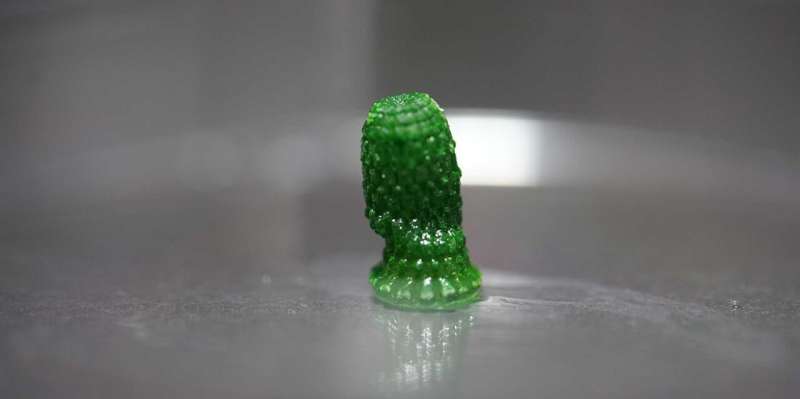
Scientists are in the process of creating a living material that can pull carbon dioxide from the air. This material contains photosynthetic bacteria that help bind CO2 in two distinct ways—by producing biomass and solid minerals.
This innovative concept is emerging at ETH Zurich, where experts from multiple fields are collaborating with bacteria, algae, and fungi. Their shared goal is to develop living materials that gain beneficial features through microbial activity—like the capacity to absorb atmospheric CO2 via photosynthesis, as explained by Mark Tibbitt, a Macromolecular Engineering professor at the institution.
A team of interdisciplinary researchers guided by Tibbitt has successfully integrated cyanobacteria into a gel that can be printed, resulting in a living material that grows and removes carbon from the air. They recently showcased their “photosynthetic living material” in a study published in Nature Communications.
Unique Feature: Two Ways to Capture Carbon
This material can be 3D printed and thrives on sunlight and artificial seawater, which contains accessible nutrients and CO2 for growth. “In the future, it could potentially help store CO2 directly within buildings,” Tibbitt suggests, having co-pioneered research on living materials at ETH Zurich.
What makes this material special is its ability to absorb significantly more CO2 than it naturally binds through growth. “It captures carbon not just as biomass but also as minerals, a unique capability of these cyanobacteria,” Tibbitt reveals.
3D-Printed Living Constructs
Yifan Cui, one of the lead researchers, notes, “Cyanobacteria are ancient life forms that excel at photosynthesis and can harness even dim light to turn CO2 and water into biomass.”
Additionally, these bacteria alter the chemical conditions around them through photosynthesis, leading to the formation of solid carbonates (like lime), providing another long-lasting carbon storage solution, as opposed to biomass alone.

Cyanobacteria: Nature’s Builders
“We specifically leverage this ability in our material,” says Cui, a doctoral researcher in Tibbitt’s group. A beneficial side effect is the minerals deposited within the structures, enhancing their mechanical strength. The cyanobacteria gradually strengthen the initially soft material.
Tests in the lab have demonstrated that this material can continuously capture CO2 for up to 400 days, primarily in the form of minerals around 26 milligrams of CO2 per gram of material. This is much higher than many other biological methods and comparable to the CO2 mineralization seen in recycled concrete (about 7 mg CO2 per gram).
Hydrogel as Support
The living material is based in a hydrogel—a gel with a high water content made of cross-linked polymers. Tibbitt’s team designed the polymer network to efficiently transport light, CO2, water, and nutrients while allowing bacteria to spread evenly throughout the material.
To maximize the lifespan and efficiency of the cyanobacteria, the researchers used 3D printing to improve the structures’ geometry, increasing the surface area, light exposure, and nutrient flow.
Co-first author Dalia Dranseike explains: “This design allows light to penetrate and ensures nutrients are distributed effectively through the material by capillary action.” Thanks to this innovative approach, the cyanobacteria remained effective for over a year, as reported by the materials researcher.
Infrastructure as a Carbon Reservoir
The team envisions their living material as an energy-efficient, eco-friendly solution for capturing atmospheric CO2 and complementing existing carbon sequestration techniques. “We aim to explore how this material might function as a coating for building facades to capture CO2 throughout a building’s lifespan,” Tibbitt shares.
There’s still much progress to be made, but architects are already experimenting with this concept in practical settings.

Exhibits in Venice and Milan
The pioneering research from ETH has made its way to the Architecture Biennale in Venice, courtesy of doctoral student Andrea Shin Ling. “Scaling up from a lab setting to full-sized installations was quite challenging,” shares Ling, who is also part of this project.
Ling, working under Professor Benjamin Dillenburger, developed a platform for biofabrication that can create living structures with functional cyanobacteria on an architectural scale for her doctorate.
For their Picoplanktonics installation at the Canada Pavilion, the team used these printed structures as living building blocks to create two tree trunk-like forms, with the largest standing about three meters tall. Thanks to the cyanobacteria, each structure can absorb up to 18 kg of CO2 annually—roughly equivalent to what a 20-year-old pine tree can absorb.
“This installation is an experiment—we have modified the Canada Pavilion to ensure it provides sufficient light, humidity, and warmth for the cyanobacteria to flourish, and we’re observing their development,” Ling explains. The team actively monitors and maintains the installation every day until November 23.
Meanwhile, at the 24th Triennale di Milano, “Dafne’s Skin” explores the use of living materials in future building designs. On a wooden-shingled structure, microorganisms develop a rich green coating that evolves the wood over time—transforming decay into a design element that absorbs CO2 while enhancing aesthetic appeal.
“Dafne’s Skin” is a collaborative project by MAEID Studio and Dranseike and is featured in the exhibition “We the Bacteria: Notes Toward Biotic Architecture,” which runs until November 9.
For more details:
Dalia Dranseike et al, Dual carbon sequestration with photosynthetic living materials, Nature Communications (2025). DOI: 10.1038/s41467-025-58761-y
If you would like to see similar Tech posts like this, click here & share this article with your friends!

